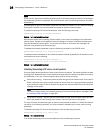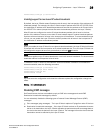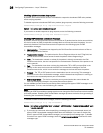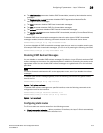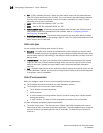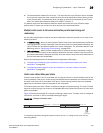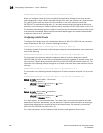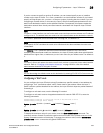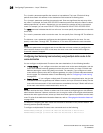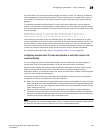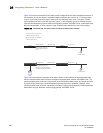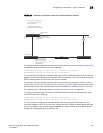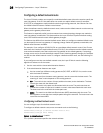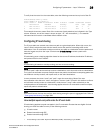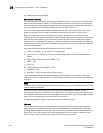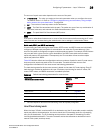
824 PowerConnect B-Series FCX Configuration Guide
53-1002266-01
Configuring IP parameters – Layer 3 Switches
26
The <ip-addr> parameter specifies the network or host address. The Layer 3 Switch will drop
packets that contain this address in the destination field instead of forwarding them.
The <ip-mask> parameter specifies the network mask. Ones are significant bits and zeros allow
any value. For example, the mask 255.255.255.0 matches on all hosts within the Class C subnet
address specified by <ip-addr>. Alternatively, you can specify the number of bits in the network
mask. For example, you can enter 209.157.22.0/24 instead of 209.157.22.0 255.255.255.0.
The null0 parameter indicates that this is a null route. You must specify this parameter to make this
a null route.
The <metric> parameter adds a cost to the route. You can specify from 1 through 16. The default is
1.
The distance <num> parameter configures the administrative distance for the route. You can
specify a value from 1 through 255. The default is 1. The value 255 makes the route unusable.
NOTE
The last two parameters are optional and do not affect the null route, unless you configure the
administrative distance to be 255. In this case, the route is not used and the traffic might be
forwarded instead of dropped.
Configuring load balancing and redundancy using multiple static routes to the
same destination
You can configure multiple static IP routes to the same destination, for the following benefits:
• IP load sharing – If you configure more than one static route to the same destination, and the
routes have different next-hop gateways but have the same metrics, the Layer 3 Switch load
balances among the routes using basic round-robin. For example, if you configure two static
routes with the same metrics but to different gateways, the Layer 3 Switch alternates between
the two routes. For information about IP load balancing, refer to “Configuring IP load sharing”
on page 829.
• Backup Routes – If you configure multiple static IP routes to the same destination, but give the
routes different next-hop gateways and different metrics, the Layer 3 Switch will always use the
route with the lowest metric. If this route becomes unavailable, the Layer 3 Switch will fail over
to the static route with the next-lowest metric, and so on.
NOTE
You also can bias the Layer 3 Switch to select one of the routes by configuring them with different
administrative distances. However, make sure you do not give a static route a higher administrative
distance than other types of routes, unless you want those other types to be preferred over the static
route. For a list of the default administrative distances, refer to “Changing administrative distances”
on page 1014.
The steps for configuring the static routes are the same as described in the previous section. The
following sections provide examples.
To configure multiple static IP routes, enter commands such as the following.
PowerConnect(config)# ip route 192.128.2.69 255.255.255.0 209.157.22.1
PowerConnect(config)# ip route 192.128.2.69 255.255.255.0 192.111.10.1



